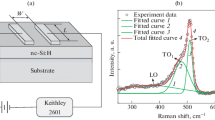Abstract
Electrodeposition of both epitaxial and polycrystalline continuous films of dense, coherent, and well-adherent silicon coatings was achieved from molten fluorides. A dissolving Si anode and an operating temperature of about 750 C were utilized. Silicon electrocrystallization epitaxy (ECE) produced films with the (111) orientation on Si substrates of the same orientation. The unintentionally doped films were of p-type character with a resistivity in the range 0.05 - 0.10 Ω-cm. Polycrystalline Si films were similarly electroplated onto various polycrystalline metal substrates. Uniform coherent, and well-adherent coatings with grain diameters as large as 40 – 50 µm were obtained. The useful rate of electrodeposition of Si could be significantly increased by the application of an alternating square wave pulse (ASWP)2technique. Cathodic current pulses as high as 300 mA/cm2 (growth rate of about 5 µm/min) were demonstrated. The cathodic current efficiencies, for all modes of growth, were about 70 – 100%. The effects of the various operating parameters, and some prospective applications to the fabrication of solar cells, are discussed.
Similar content being viewed by others
References
F. Ullik, Ber. Wien Acad.52, 115 (1865).
A. Minet, C. R. Acad. Sci.112, 1215 (1891).
K. Grjotheim, K. Matiasovsky, P. Fellner, and A. Silny, Can. Met. Quart.10, 79 (1971).
G. Boe, K. Grjotheim, K. Matiasovsky, and P. Fellner, Ibid, 179 (1971).
R. Monnier and D. Barakat,Compt. Rend. Congr. Intern. Chem. Ind. 3le, Liege, 1958; C. A.,54, 3000 (1960).
R. Monnier and J. C. Giacometti, Helv. Chim. Acta47, 345 (1964).
R. Monnier and Ph. Grandjean, Helv. Chim. Acta43, 2163 (1960).
R. Monnier, et al., U.S. Patents 3,219,561 (1965); 3,254,010 (1966).
N. S. Fortunatov, Zap. Inst. Khim. Ukr. Akad. Nauk2, 257 (1935); C. A. 31, 4599 (1937).
M. Dodero, Bull. Soc. Chim. France6, 209 (1939); C.A.33, 8504 (1939).
M. Dodero,Silicium Schwefel, Phosphate, Colloq. Sek. Anorg. Chem. Intern. Union Reine Angew. Chem. Munster 1954, p. 15; C. A.,51,, 12705 (1957).
D. R. Stenn and Q. H. McKenna,Silicon, U.S. Patent 2,892,763 (1959).
L. P. Hunt, L. D. Crossman, and M. Wolf, inERDA’s first Semiannual Solar Photovoltaic Conversion Conference. University of California, Los Angeles, California, July 22–25, 1975.
G. W. Mellors and S. Senderoff, Canadian Patent 688,546 (1964).
S. Senderoff, Metallurgical Reviews11, 97 (1966).
G. W. Mellors and S. Senderoff, J. Electrochem. Soc.112, 266 (1965);112, 840 (1965);113, 60 (1966);114, 586 (1967);118, 220 (1971).
N. C. Cook, J. D. Evans, and B. A. Fosnocht, inProc. Intern. Conf. on Protection Against Corrosion by Metal Finishing, Basel, 1966.
N. C. Cook, U.S. Patent Re. 25,630 (1964).
N. C. Cook, U.S. Patents 3,024,175 (1962); 3,024,176 (1962); 3,479,158 (1969); 3,479,159 (1969); 3,489,536 to 3,489,540 (1970); 3,489,659 (1970); 3,514,272 (1970); 3,522,021 (1970).
U. Cohen, Ph.D. Dissertation, Stanford University (1977).
U. Cohen and R. A. Huggins, J. Electrochem. Soc.123, 381 (1976).
U. Cohen, U.S. Patent 3,983,012 (September 1976).
U. Cohen, Patent Pending.
U. Cohen and R. A. Huggins, Elect. Mat. Conference, University of Utah, Salt Lake City, Utah, June 23–25, 1976 (Abstract No. A6).
P. F. Kane and G. B. Larrabee,Characterization of Semiconductor Materials, Texas Inst. Elect. Series, McGraw-Hill Book Co. (1970).
Uri Cohen and R. A. Huggins,High Rate Electrodeposition of Niobium from Molten Fluorides Using Alternating Square Wave Pulses, Electrochem. Soc. Meeting, Dallas, Texas, October 5–10, 1975 (Abstract No. 147).
A. R. Despic and K. I. Popov, "Transport-Controlled Deposition and Dissolution of Metals," inModern Aspects of Electrochemistry, Vol. 7 (ed. by B. E. Conway and J. O’M. Bockris), Plenum Press, N. Y. (1972).
U. Cohen and W. A. Tiller, to be published.
C. E. Wicks and F. E. Block,Thermodynamic Properties of 65 Elements — Their Oxides, Halides, Carbides, and Nitrides, U.S. Bur. Mines Bull.605 (1963).
G. F. Wakefield,Solar Cell Definitions, in ERDA’s first Semiannual Solar Photovoltaic Conversion Conference, University of California, Los Angeles, California, July 22–25, 1975.
Author information
Authors and Affiliations
Additional information
This was paper A-6 in the 18th Annual Electronic Materials Conference, Salt Lake City, June 23–25, 1976.
Rights and permissions
About this article
Cite this article
Cohen, U. Some prospective applications of silicon electrodeposition from molten fluorides to solar cell fabrication. J. Electron. Mater. 6, 607–643 (1977). https://doi.org/10.1007/BF02660341
Received:
Issue Date:
DOI: https://doi.org/10.1007/BF02660341




